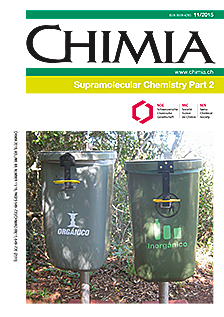Development of an LC-MS/MS Method for the Assessment of Selected Active Pharmaceuticals and Metabolites in Wastewaters of a Swiss University Hospital
DOI:
https://doi.org/10.2533/chimia.2015.684Keywords:
Hospital wastewaters, Liquid chromatography, Mass spectrometry, PharmaceuticalsAbstract
A multi-residue analytical method was developed and validated for the quantification of 11 selected active pharmaceutical ingredients (API) and 2 human metabolites in hospital effluents using solid-phase extraction followed by liquid chromatography coupled to tandem mass spectrometry (LC-MS/MS). Targeted analytes belong to different therapeutic classes: non steroidal anti-inflammatory drugs (NSAID), analgesics, antibiotics and psychiatric drugs. Solid-phase extraction recoveries ranged between 21 and 101% for the selected API. Calibration curves were built with 6 standard samples prepared in ultrapure water ranging from 0.05 to 10 ?g/L and showed regression coefficients above 0.994. The instrumental detection limits (IDL) varied between 0.05 and 5 ?g/L, and the method detection limits (MDL) between 0.1 and 100 ng/L. Precision of the method, evaluated with spiked water samples at four different concentrations, varied between 84 and 117% for all compounds and an overall variability below 20%, with the exception of carbamazepine (71–123%). Except for two compounds, recoveries of spiked hospital wastewaters at four different concentrations (0.1, 1, 10 and 100 ?g/L) varied between 44 and 133%, with relative standard deviation (RSD) between 0.6 and 28.5%. The evaluation of the matrix effects showed that diluted samples exhibit lower signal suppression. Analysis of effluent samples from a Swiss university hospital resulted in a mean detection frequency of 92% for the selected compounds, with concentrations up to 1535 ?g/L for the analgesic paracetamol.Downloads
Published
2015-11-25
Issue
Section
Note
License
Copyright (c) 2015 Swiss Chemical Society

This work is licensed under a Creative Commons Attribution-NonCommercial 4.0 International License.
How to Cite
[1]
S. Daouk, S. Fleury-Souverain, Y. Daali, Chimia 2015, 69, 684, DOI: 10.2533/chimia.2015.684.







